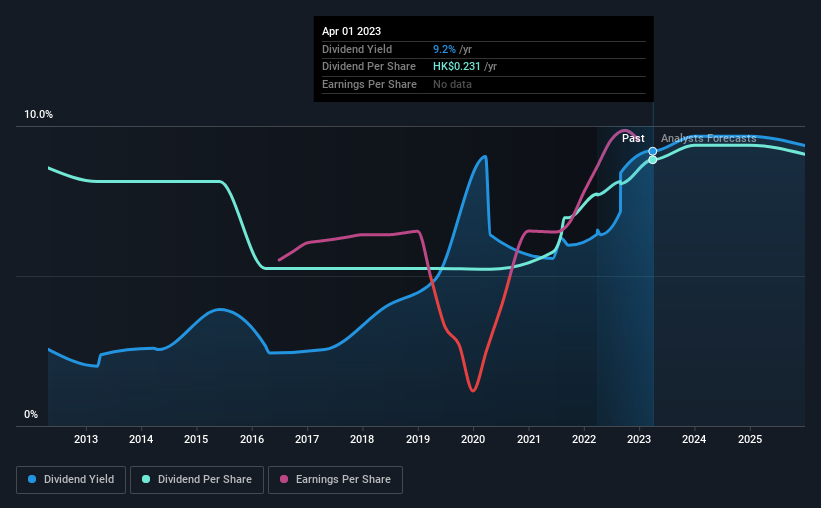First Pacific (HKG:142) Is Paying Out A Larger Dividend Than Last Year
First Pacific Company Limited's (HKG:142) dividend will be increasing from last year's payment of the same period to $0.115 on 6th of July. This makes the dividend yield 9.2%, which is above the industry average.
Check out our latest analysis for First Pacific
First Pacific Doesn't Earn Enough To Cover Its Payments
A big dividend yield for a few years doesn't mean much if it can't be sustained. However, prior to this announcement, First Pacific's dividend was comfortably covered by both cash flow and earnings. This means that most of what the business earns is being used to help it grow.
Earnings per share is forecast to rise by 33.7% over the next year. However, if the dividend continues along recent trends, it could start putting pressure on the balance sheet with the payout ratio reaching 192% over the next year.

Dividend Volatility
Although the company has a long dividend history, it has been cut at least once in the last 10 years. Since 2013, the annual payment back then was $0.0285, compared to the most recent full-year payment of $0.0294. Its dividends have grown at less than 1% per annum over this time frame. It's encouraging to see some dividend growth, but the dividend has been cut at least once, and the size of the cut would eliminate most of the growth anyway, which makes this less attractive as an income investment.
The Dividend Looks Likely To Grow
Given that the dividend has been cut in the past, we need to check if earnings are growing and if that might lead to stronger dividends in the future. It's encouraging to see that First Pacific has been growing its earnings per share at 27% a year over the past five years. Earnings per share is growing at a solid clip, and the payout ratio is low which we think is an ideal combination in a dividend stock as the company can quite easily raise the dividend in the future.
We Really Like First Pacific's Dividend
Overall, a dividend increase is always good, and we think that First Pacific is a strong income stock thanks to its track record and growing earnings. The company is easily earning enough to cover its dividend payments and it is great to see that these earnings are being translated into cash flow. Taking this all into consideration, this looks like it could be a good dividend opportunity.
Market movements attest to how highly valued a consistent dividend policy is compared to one which is more unpredictable. Meanwhile, despite the importance of dividend payments, they are not the only factors our readers should know when assessing a company. Case in point: We've spotted 2 warning signs for First Pacific (of which 1 is a bit concerning!) you should know about. Looking for more high-yielding dividend ideas? Try our collection of strong dividend payers.
New: AI Stock Screener & Alerts
Our new AI Stock Screener scans the market every day to uncover opportunities.
• Dividend Powerhouses (3%+ Yield)
• Undervalued Small Caps with Insider Buying
• High growth Tech and AI Companies
Or build your own from over 50 metrics.
Have feedback on this article? Concerned about the content? Get in touch with us directly. Alternatively, email editorial-team (at) simplywallst.com.
This article by Simply Wall St is general in nature. We provide commentary based on historical data and analyst forecasts only using an unbiased methodology and our articles are not intended to be financial advice. It does not constitute a recommendation to buy or sell any stock, and does not take account of your objectives, or your financial situation. We aim to bring you long-term focused analysis driven by fundamental data. Note that our analysis may not factor in the latest price-sensitive company announcements or qualitative material. Simply Wall St has no position in any stocks mentioned.
About SEHK:142
First Pacific
An investment holding company, engages in the consumer food products, telecommunications, infrastructure, and natural resources businesses in the Philippines, Indonesia, Singapore, the Middle East, Africa, and internationally.
Very undervalued with solid track record and pays a dividend.
Market Insights
Community Narratives



